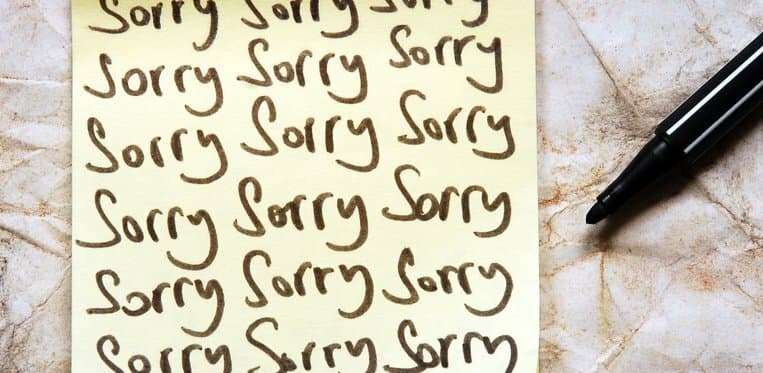The power of apologies is legendary. At least, it is if you’ve listened to my episodes on how to repair relationships, on how to take responsibility when you screw up, and on how to criticize someone without looking like a jerk.
But, they’ve got to be done right, or the other person won’t even hear them. In the workplace, a proper apology might make the difference between being seen as a team player or being considered “that person.”
Bernice and Melvin are not having a good morning. They just finished taking inventory for Bernice’s plant store, Green Growing Things. Melvin, in his glee, went to close the inventory program. When the program asked, “Do you really want to exit without saving the data?” he clicked Yes by habit. Oops. An entire day’s work, lost.
Bernice is going ballistic. Melvin is trying his best to apologize, but nothing’s working.
“I promise I’ll do the inventory on my own this weekend,” he cries.
“Yes, but you aren’t even sorry!” she yells.
“I am, too! Please forgive me!”
“Forgive you? Forgive you? Why should I forgive you when you aren’t sorry?”
“But I am sorry!”
And round and round it goes.
From the outside, it sure seems that Melvin is offering an apology, and that Bernice is refusing to accept it. But that’s not what’s happening at all. They just recognize apologies differently. In the book When Sorry Isn’t Enough, Gary Chapman and Jennifer Thomas share the results of a study they did of how people give and receive apologies. The bad news: There are five different ways people apologize. The good news: There are only five.
Apology Language #1: Expressing Regret
Expressing Regret is Bernice’s primary apology language. To her, an apology is first and foremost emotional. Someone truly feels bad about what they’ve done. An apology must show that someone sincerely feels regretful, guilty, or ashamed.
Melvin says, “I’m sorry,” but his voice tone says, “Panic!” Bernice is picking up on his tone, not his words. She wants to know there’s real regret behind his apology, not just that he can say the words. Expressing Regret sounds like, “I feel awful about what I’ve done.” (Said in an appropriate tone of voice.)
Apology Language #2: Accepting Responsibility
Bernice’s secondary apology language is Accepting Responsibility. She wants to hear that the other person knows it’s their fault. This is as simple as saying, “I was wrong.” But as simple as it sounds, many of us just can’t say those words. We can say, “You were wrong.” We can say, “Politicians are wrong.” But, we can’t quite say, “I was wrong.”
But, that’s all that someone with the Accepting Responsibility apology language wants to hear, a simple admission of fault. Melvin’s apologizing, but he’s not saying that he was wrong. Accepting responsibility sounds like, “I’m sorry. I was wrong. It was my fault.”
Apology Language #3: Genuine Repentance
Genuine Repentance is similar to Expressing Regret in that it must come from the heart. But, it must also come with a promise to change, so the problem doesn’t happen again.
Even though Melvin may plan to change going forward—perhaps by re-reading every dialog box twice before clicking a button—if he doesn’t say so to Bernice, she won’t know that. Genuine Repentance sounds like, “I’m sorry. It won’t happen again. Next time I’ll re-read the dialog box twice before clicking a button. And I’ll turn on auto-save. And make backups.”
Apology Language #4: Requesting Forgiveness
Requesting Forgiveness asks the injured person to forgive. It lets them know they were wronged, that forgiveness is needed to repair the relationship. Even though you may believe that a request for forgiveness is implied in any apology, someone whose apology language is Requesting Forgiveness needs to hear it out loud.
An apology can be as simple as saying, “I was wrong.”
Keep in mind that a request for forgiveness won’t necessarily be granted. The apology shows that you recognize the need to be forgiven. Whether or not the forgiving happens, however, is up to the person receiving the apology. Requesting Forgiveness sounds like, “I’m sorry. Please forgive me.”
Apology Language #5: Making Restitution
Finally, we come to Making Restitution. Making Restitution involves justifying the wrong, and finding a way to make amends. You gotta make up for what you did. How you make up for it depends on the person. You have to make up for it in a way that the other person values. If you say “I’m so sorry. Here is a pair of tickets to the game Sunday evening” to someone who prefers cooking to sports, you’re not making amends. “Here is a pair of tickets to the filming of Iron Chef Sunday evening” will work much better.
Making Restitution might mean doing what’s needed to fix what you screwed up. It’s probably the most labor-intensive apology language. It also happens to be my number one apology language. Making Restitution sounds like, “I’m sorry. I was sloppy. I’d be glad to help with the marketing report so you can go home early tonight.”
Match Their Apology Language, Not Yours
Since our primary apology language is how we recognize apologies, we tend to give apologies in the same language. After all, if “I’m sorry” means “I’ll make restitution,” then we’ll be tempted to make restitution when we want to apologize, even if the other person doesn’t care about restitution, but does care about hearing us say, “I was wrong.”
Melvin’s top two apology languages are Making Restitution and Requesting Forgiveness. He’s saying, “I’ll fix the problem. Please forgive me.” Those aren’t a match for Bernice. Her top apology languages are Expressing Regret and Accepting Responsibility. She just wants Melvin to say, sincerely, “I feel really ashamed of my screwup. It was my fault.” She’ll say, “Of course I accept your apology! It’s all right! Let’s go down to the soda shop and share a Tofutti eclair to make up.” She doesn’t even need him to fix the problem.
When making an apology, use the other person’s apology language, so they really hear you. If you don’t know someone’s apology language, try all five: “I’m sorry. I feel awful about what happened. I was wrong and I take full responsibility. Here’s what I’ll do differently in the future, and here’s how I’ll make it right, now. Can you forgive me?”
When you’re receiving an apology, be sensitive to all five languages, not just your own. Even if someone isn’t using your preferred apology language, they may be quite sincere, using their own. Listen for it. An apology is a special act, meant to make things better. Learn to give and receive apologies in a way that people can hear and that repairs and strengthens your relationship.
More From Quick and Dirty Tips
This article was originally published on Quick and Dirty Tips. It has been republished here with permission.

